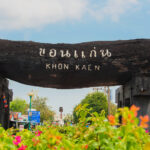Hat Yai, Thailand | Key Success Factors of Flooding Management Policy
Hat Yai, Thailand
Date: July 5, 2023

Fast Facts
- Mayor: Sakhorn Thongmunee
- Population: 191,696
- Area: 21.24 Km²
- GCoM Signatory since 2016
- Hat Yai is the major economic centre of lower southern Thailand and is famous as its shopping destination for both Thais and foreigners.
- It is the home to the third-largest reclining statue in the world but one of the cities that were severely affected by flooding in Thailand.
Background
Hat Yai, a coastal town in Southern Thailand, has been experiencing rapid urbanisation and commercialisation. However, due to its location in a low-lying floodplain area, the city has long been impacted by annual flood occurences, with major flood events occurring at 12-year intervals. In 2010, the city faced a devastating flood that impacted up to 80% of the Hat Yai area, putting 30,000 households at risk. The economic losses escalated from THB 1,000 million in 1988 to THB 10,000 million in 2010, highlighting the ineffective flood management measures in place at that time. This flood event served as a turning point for Hat Yai, as it marked the beginning of increased cooperation in disaster management efforts. [1]
Solutions Implemented
Hat Yai identified the need to enhance investment in flood prevention infrastructure after the disastrous flood disaster in 2000. Floodwalls, levees, drainage systems, and the construction of six large water diversion canals were implemented. Despite these efforts, Hat Yai was hit by another major flood in 2010, causing even more damage than the previous decade. This event prompted the administration of Hat Yai to realise that flood prevention alone was insufficient. The city shifted its focus towards learning how to adapt and minimise the impacts of floods through a systematic response.
To achieve this, Hat Yai established a flood working group comprising representatives from the city administration, local communities, the business sector, academia, and NGOs. This multi-stakeholder approach and integrated planning across various agencies have been vital to the programme’s success. The working group conducted a Vulnerability Assessment Report, which involved mapping out the city to understand water flows and formulate action plans related to water management and disaster risk reduction. Effective communication and coordination were also emphasised, leading to the establishment of a Climate Change Resilience Learning Centre for information sharing and education. The centre produced a flood risk mitigation handbook, facilitating decision-making and implementation.
Hat Yai focused on supporting affected individuals. To provide financial assistance, the government constructed flood evacuation centres and established an insurance fund. Furthermore, investments were made in an early flood warning system to enhance preparedness and response.
The media played a crucial role in sustainable flooding management by raising public awareness. Real-time CCTV footage of critical junctions in the city was made available to the public, creating awareness of water levels. A popular website provided disaster preparedness information, including rainfall data and satellite imagery, and is now used by radio stations to provide early warnings.
Hat Yai has proved its commitment to flood management and resilience through these comprehensive efforts. Collaboration between the city and the Asian Cities Climate Change Resilience Network (ACCCRN) has been instrumental in supporting these initiatives.
Results and Solutions Learned
The implementation of the flooding management policy in Hat Yai was a resounding success, earning the Thailand Public Service Award in 2012. The achievement of this goal has opened up new possibilities for the municipal government to further enhance the public consultation process for infrastructure development and other projects. The city recognises the potential to scale up these efforts to achieve not only city-wide resilience but also river basin resilience. [2]
Three key lessons have been learned from this experience. First, the importance of striking a balance between self-interest and public interest has been underscored. Decision-making processes must consider the needs and concerns of all stakeholders to ensure that the outcomes benefit the community as a whole. Second, different levels of stakeholders must be involved. Collaboration and cooperation among various actors, including government agencies, local communities, businesses, academia, and NGOs, are necessary to achieve effective and sustainable results. Finally, public awareness plays a critical role in building resilience. In order to develop a culture of resilience within the community, it is critical to educate and engage the public about flood hazards, preparedness measures, and the necessity of sustainable practices.
Building on these lessons, Hat Yai is poised to continue its journey toward urban climate resilience, with the potential to expand its efforts to the broader river basin context. By embracing these principles and leveraging the expertise gained from successful flood management, Hat Yai is well-positioned to further strengthen its resilience and contribute to the overall well-being of its residents.
[1] Martin Jacobson, “From Flood Prevention to Resilience,” Hat Yai Resilience, November 11, 2015, https://wwf.panda.org/wwf_news/?256130/Hat-Yai-resilience
[2] Somporn Siriporananon and Parichart Visuthismajarn, “Key success factors of disaster management policy: A case study of the Asian cities climate change resilience network in Hat Yai city, Thailand,” Science Direct, August, 2018, https://www.sciencedirect.com/science/article/pii/S2452315118300201






